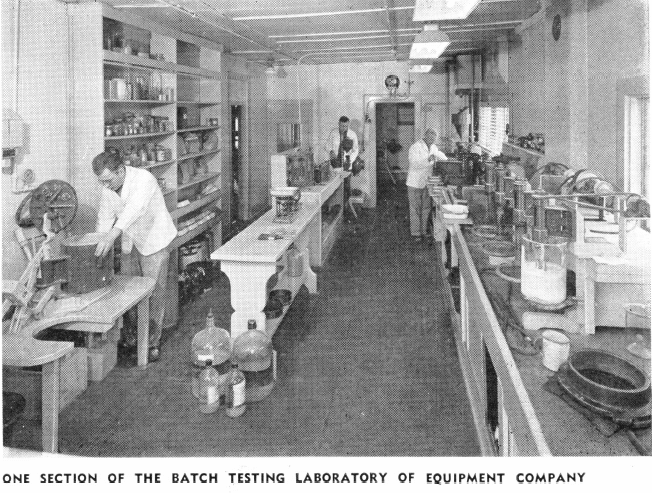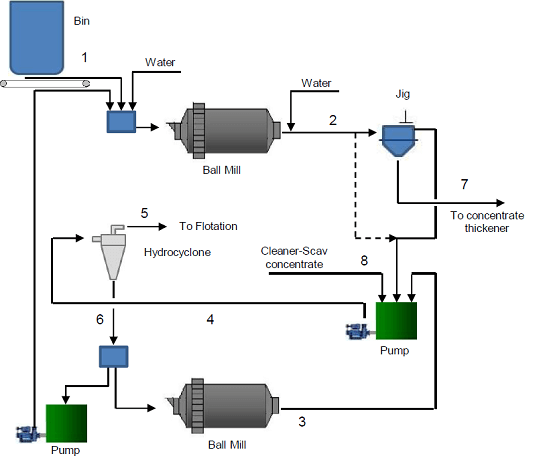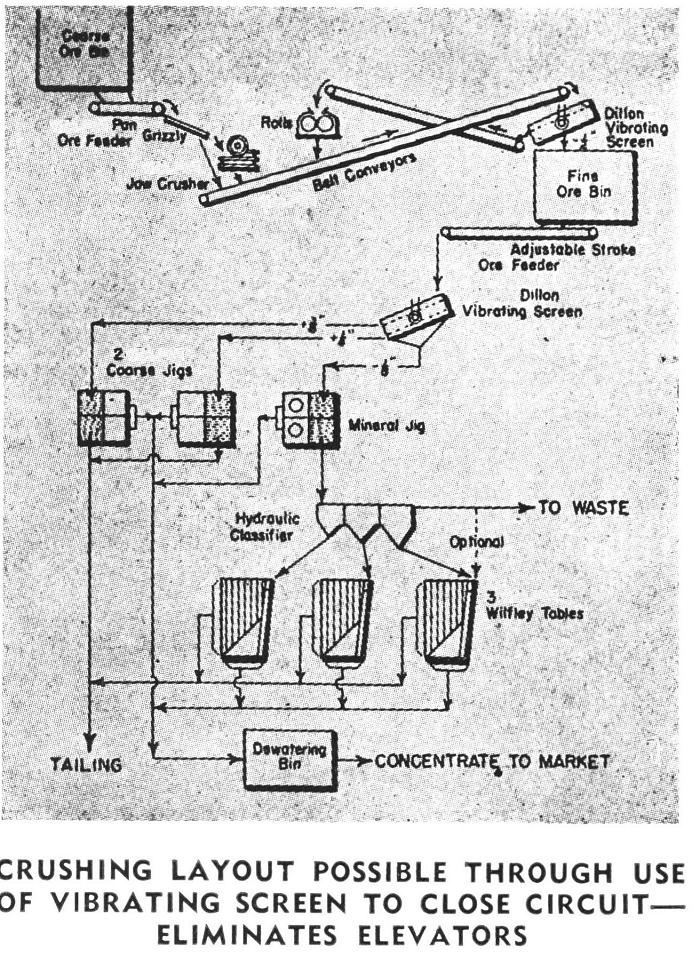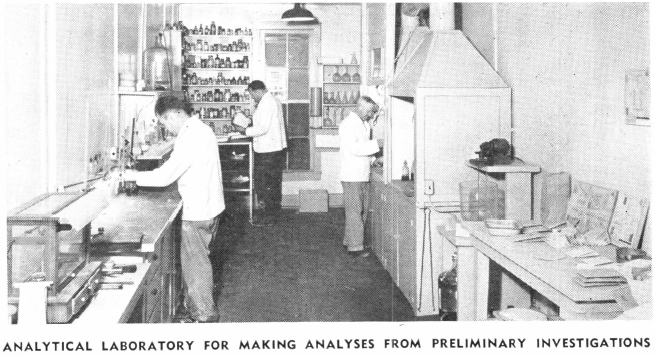Table of Contents
The Mineral Industries have for many years recognized the importance of small-scale ore dressing tests for determining the amenability of ores to various methods of concentration. The successful development of the flotation process, which was accomplished with the aid of small-scale laboratory machines, gave a decided impetus to the laboratory testing of ores. Today the small-scale testing of ores is recognized as necessarily the first step in the development of a successful ore treating plant.
Why Laboratory Metallurgical Testing
Ore testing laboratory installations are usually planned with a view of making not only a critical study of every individual ore tested but also of each step in the process which is evolved for the individual ore treatment. Such a study should establish the most desirable method of treatment and give all necessary data upon which selection of equipment could be based.
The methods used in any testing laboratory should be designed to duplicate as closely as possible the actual conditions in every step of the process under which the ore will be treated in the regular milling operation. Such a requirement makes it vital that the greatest possible amount of flexibility be obtained in the ore testing laboratory, and within certain limits a wide range of capacity is also desirable. To meet these conditions, the Testing Laboratory of 911metallurgy is made up of the following divisions:
- Crushing, screening, and sampling.
- Batch testing laboratory.
- Pilot concentration mill.
- Analytical laboratory.
The information to be obtained in the various tests, which comprises the work of the testing laboratory generally, may be grouped as to the aim of the work done under the four following items:
- The examination and preliminary testing of samples for the purpose of determining the presence of commercially valuable content or of determining the advisability of conducting more extensive tests.
- The determination of the amenability of metallic and non-metallic ores, industrial products, and industrial by¬products to various methods of concentration. This investigation should also give the possible production of marketable grades of concentrates and should determine flowsheets for correct methods of treatment of the materials tested.
- Tests primarily aimed toward the supplying of engineering data sufficiently comprehensive to afford a basis for recommendations as to the construction and operation of a commercial-size treatment plant.
- A large-scale pilot mill test on tonnage lots of mill-run ore to check recommended flowsheets under actual milling conditions.
The latest advances in ore dressing methods and techniques are closely followed by the staff of the ore dressing laboratory. All methods in ore dressing are carefully considered, for example:
- The Sink and Float Process which has been used to advantage in certain large capacity plants, through the elimination of a large quantity of waste gangue material;
- The use of the Electrostatic Separation Process and the Magnetic Separation Process for the raising of final concentrate grade. Considerable work is also done, in the course of testing the various ores, on the uses and advantages or disadvantages of various types of reagents.
Ore Sample Preparation
The crushing, screening, and sampling division is provided with equipment capable of handling samples varying in quantity from a few pounds to a carload of ore. A 5″x 6″ Jaw Crusher is hand-fed and delivers onto a 10″x 10″ steel sampling plate from which large samples are cut into quarters or fifths and shoveled into receiving bins. Smaller samples are delivered into containers and split by means of a Jones Sampler. A set of 6″ face x 10″ diameter crushing rolls, also hand-fed, delivers into sample containers which may be dumped on the steel sampling plate or passed over the Jones Sampler.
For wet screening or use as a limiting screen in regular stage-crushing of ore samples, a 1½’x 3′ Vibrating Screen is mounted on a movable frame which can be placed in the pilot mill flowsheet where needed. One small 2½” x 3½” laboratory jaw crusher, one 8″ Sample Pulverizer, and a Fairbanks portable platform scale complete the equipment in this section.
The engineering data, which is most commonly desired from the crushing, screening, and sampling section, include the following necessary information upon which can be based the capacity and most efficient flowsheet for the grinding section of a commercial plant:
- Crushability of ores upon which to base recommendations for the crushing flowsheet of the proposed plant.
- Application of Vibrating Screen for certain problems.
- Percentage of fines produced in crushing.
The information regarding the crushability of ores is conveniently secured by measuring the power consumed by the crusher during the crushing of a weighed quantity of ore in a measured time interval. When test-crushing an ore by this method, extreme hardness or abrasion is readily apparent. Information required to establish the capacity of the Vibrating Screen is secured by operation of the screen at various slopes with a series of feed rates; screening efficiency is determined by laboratory screen analyses of samples of the products.

Laboratory Batch Testing
The batch ore testing section is equipped to handle any type of batch test. The test results, in many instances, are all that are necessary to provide the information upon which to base recommendations for a commercial plant. Another important function of batch testing is to determine the advisability of carrying out a full-scale pilot plant test. This section is equipped with the necessary machines to accomplish the following general operations:
- Wet or dry grinding by ball, pebble, or rod mill, to obtain the information on the various methods of grinding and the advantages or disadvantages of each. Two 12″x 5″ Laboratory Ball Mills, two pebble grinding jars on rolls, and one laboratory rod mill are available.
- Gravity Concentration equipment includes two Small Laboratory Mineral Jigs, one 4″x 6″ Mineral Jig, and 2 Wilfley Concentrating Table with both sand and slime decks.
- Flotation includes two “Sub-A” Laboratory 2,000-gram cells, two 500-gram cells, and one 1,000-gram cell.
- Cyanidation or other solubility test equipment is available to conduct tests to determine the amenability to cyanidation or chemical solubility; units comprise one multiple unit of four Wallace Type Super-Agitators, one multiple set of Bottle Type Agitators, and one continuous sand leaching laboratory unit.
- Hydraulic classification tests may be carried out in one free settling hydraulic tube and one 4-spigot Hindered Settling Hydraulic Classifier.
- Thickening, filtering, and drying of pulp products equipment consists of one laboratory size thickener jar with rake mechanism to duplicate actual thickener operation, three 12″x 3″ Vacuum Filters, and one 12″ Counter-Balanced Pressure Filter. A Electric Drying Oven is available for drying concentrates, middlings, or tailings pulp before screen analyses.
- Screen analyses of pulp products; equipment consists of one Testing Sieve Shaker, and a set of Tyler Standard Sieves with complete mesh range from one inch to 325 mesh.
- Amalgamation equipment consists of a barrel amalgamation jar operated on rolls, and silver plated amalgam pan. The amalgamation jar also serves a number of other purposes such as fine grinding with pebbles, washing or agitation with acids or other chemicals.
Accessory laboratory equipment in the batch ore testing section includes one binocular microscope, one petrographic microscope, one ultraviolet lamp, one Beckman electric pH meter, one LaMotte pH comparator, electric timers, time switches, and magnets.
The data supplied by the testing in this section includes:
- Grindability of ores to determine sizes of grinding mills.
- Settling rates of pulps to determine sizes of thickeners.
- Agitation time and pulp densities to determine sizes of agitators and conditioners.
- Flotation data including general amenability to flotation treatment, concentrate grades, optimum flotation time, and densities for determining capacities and reagent combinations.
- Filtering rates to determine filter sizes and types most advisable.
- Special amenability tests to determine the grade of concentrates and the recoveries by either the Mineral Jig, the Unit Flotation Cell, or both, in the ball mill classifier circuit.

Metallurgical Pilot Plant
Metallurgical Laboratory Testing Methods
The manipulation of ore tests in the batch laboratory and the conducting of large-scale tests in the pilot plant should be designed to conform as nearly as possible to the conditions which will exist in the proposed milling operation. Consideration should of course be given to any factors which are beyond the control of the operators of the commercial milling plant such as climatic conditions, elevation, etc. Water supply as it is available to the commercial plant should be duplicated as closely as possible in conducting both small and large-scale tests.
Preliminary Process Scoping Tests
Every ore sample tested is given a thorough preliminary examination to determine the character, extent, and association of the mineral content, and the type of test to be conducted is determined from this examination. The following is an outline of the method of conducting these preliminary determinative tests:
The sample after stage crushing to minus 10-mesh, retaining portions at various sizes for possible future use, is agitated with an equal weight of city water, the pH of which is known. The pH and soluble salt content of the resulting pulp water are determined.
The pulp is then placed on a vanning plaque and examined under the microscope and ultraviolet lamp, and then carefully panned by stages during the examination. The final concentrate is given a thorough microscopic examination and qualitative chemical or micro-chemical tests for determination of all valuable minerals. Bulletin No. 914 of the U. S. Geological Survey entitled “Microscopic Determination of the Ore Minerals,” written by N. M. Short, is found to be a valuable guide in making the micro-chemical tests.
Occasionally an out-of-the-ordinary test is necessary. For instance, in the case of a scheelite ore the sample which is preferably crushed to minus 4-mesh is screen analyzed and the grain count of free scheelite and middling grains present in each screen fraction is made under the ultraviolet lamp. This test affords a guide to the degree of association of the scheelite with the gangue and is necessary in order to conduct a test which includes gravity concentration to produce maximum recovery of scheelite by preventing oversliming in the crushing and grinding circuit.
Batch Laboratory Testing
In all the test work, either large or small scale, much attention is given to the grinding of ore, since this is one of the most costly steps in ore concentration. The grindability of an ore is determined by special grind tests whereby the screen analyses of the products from the grind tests are directly compared to results secured on certain standard grind test ores.
Samples of ores of different grindability have been secured from actual milling plants where all grinding data are known. Data includes mill dimensions inside the liners, tonnage treated, power consumption, grinding media consumption, pulp density in mill, type of classification, circulating load of circuit, and degree of comminution.
The samples secured from these operating plants were then crushed for laboratory tests to minus 10 mesh and a series of grind tests conducted under identical conditions with the 12″x 5″ Laboratory Ball Mill. Subsequent screen analyses of the products from these tests afforded data which permitted the plotting of curves showing the amount of minus 200-mesh produced per unit of time for each ore hardness. These data afford a direct comparison with similar data secured by submitting an ore with unknown grindability to similar grind tests and the grindability of the unknown ore is determined by the comparison.
These data have enabled the laboratory staff to classify the various ores by standards of Hard, Medium-hard, Medium, Medium-soft, and Soft ores to grind.
https://www.911metallurgist.com/metallurgy-laboratory-equipment/
Laboratory grinding of ore samples for batch testing is performed in a manner to approximate the conditions to be expected in mill operation. Samples are stage ground with classification between stages. This classification is by screening if the ore in practice is to be screen classified. If a regular closed circuit with ball or rod mill and mechanical classifier is to be used, the test charge is given an unfinished grind, removed from the mill and hand classified and the resulting sands returned to the mill for additional grinding. Two or three stages are generally sufficient to approximate a regular closed circuit grind.
Many ores require a certain amount of grinding following crushing before a sufficient amount of free mineral particles are present in the pulp to justify concentration. Such ores would be treated by placing the Mineral Jig in the grinding circuit; taking the ball mill discharge over the jig before classification and returning the unfinished sand to the mill.
Gravity concentration by means of the Mineral Jig includes amenability tests on the 1-M Laboratory Mineral Jig; for determining capacities a 4″x 6″ Mineral Jig is used. Tests on the Flash Flotation Cell and the Mineral Jig are often conducted in series, the jig test preceding the unit cell test or each as the first step in separate combination of tests; the unfinished tailing is subjected to finished grind and regular “Sub-A” Flotation.
In testing with the Mineral Jig, the wedge wire screen opening should be approximately equal to two times the diameter of the largest particle of concentrate to pass through it and the lower layer of bedding, which may consist of steel shot, should be made of rounded shot of a diameter two times the screen opening.
To prove the application of the Unit Flotation Cell to a particular ore, laboratory test conditions to be considered are:
- Fineness of grind of ball mill discharge.
- Pulp density.
- Flotation time.
- Reagent additions.
- Type of machine for particular application.

The Laboratory tests are ordinarily carried out on ore charges which have been dry crushed through rolls to minus 10-mesh. A charge of from 2,000 to 2,500 grams is placed in the 12″x 5″ Laboratory Ball Mill at a solids to water ratio of 2 to 1. A flash grind of from three to five minutes is then given with all reagents added that are to be used in the Unit Cell.
The 1,000-gram “Sub-A” Laboratory Flotation Machine is used for these tests because construction features are particularly desirable for this application. The spitzkasten of this machine is short, the side walls are steep, and the circulation in this cell corresponds very closely to that of a commercial Unit Flotation Cell.
The use of 2,000 to 2,500 grams of ore in the machine produces a pulp density of from 35 to 40 percent solids with average density ores. The “Sub- A” principle incorporated into this machine allows the desired agitation of a pulp as coarse as 8-mesh without sanding up. Flotation time is entirely within the control of the operator and is generally held at two to four minutes never more than five minutes. The full advantage of a passing circulating load cannot be realized in this test as a ball mill discharge through the machine cannot be secured. However, flotation time is allowed to compensate somewhat for this disadvantage.
The reagent additions which are made in the ball mill are determined by previous trial tests and are regulated in amount to afford proper conditions for flotation. Proper alkalinity or acidity control is secured by determining the pH of the pulp water. In general, the amount of reagents used, in comparison to the amount required in a complete flotation test, is in proportion to the pulp water content of the charge.
In the case of a differential flotation test for example the production of a lead concentrate and a zinc concentrate from a galena-sphalerite ore the zinc inhibiting reagents are used in the ball mill. The Unit Cell then produces only a lead concentrate, leaving subsequent regular flotation of the classifier overflow to make a scavenger lead concentrate and a zinc concentrate.
The Unit Flotation Cell concentrate is considered a finished product without any further treatment. The tailing is classified at the desired mesh size, the sand reground to the desired finished grind and this pulp subjected to regular flotation tests in the 2,000- gram “Sub-A” Laboratory Flotation Machine. Dilution control, resulting from the washing out of the machine, is necessary to prevent over-dilution in following steps of the test.
All the products of the complete test are dried, carefully weighed, and assayed. From the data obtained the proportion of values recovered by the Unit Cell and those secured in all products of the entire test are easily calculated.
The procedure of batch testing of the ground pulp by “Sub-A” Flotation is designed to supply data which includes correct flotation time, pulp density, pulp temperature, most efficient reagent combination, and most economical degree of comminution to liberate the valuable mineral. The final flotation tailing is generally passed over the Wilfley Table for informational purposes and the final tailing subjected to screen analysis with assay of the various screen sizes to determine the extent of association with gangue of the valuable mineral.
Final Metallurgical Report: CONCLUSION
The results of many tests in the laboratory, on ores from all parts of the world, indicate that every ore presents a problem which is in some respects different from any other ore, although general classifications can be made of those which present particular problems. Space does not permit an extended discussion of these various problems but it is hoped that additional articles may be presented in the future.
Source: This article is a reproduction of an excerpt of “In the Public Domain” documents held in 911Metallurgy Corp’s private library.
